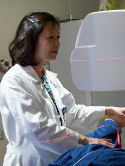Early toxicity in patients treated with postoperative proton therapy for locally advanced breast cancer Journal Article
| Authors: | Cuaron, J. J.; Chon, B.; Tsai, H.; Goenka, A.; Deblois, D.; Ho, A.; Powell, S.; Hug, E.; Cahlon, O. |
| Article Title: | Early toxicity in patients treated with postoperative proton therapy for locally advanced breast cancer |
| Abstract: | Purpose To report dosimetry and early toxicity data in breast cancer patients treated with postoperative proton radiation therapy. Methods and Materials From March 2013 to April 2014, 30 patients with nonmetastatic breast cancer and no history of prior radiation were treated with proton therapy at a single proton center. Patient characteristics and dosimetry were obtained through chart review. Patients were seen weekly while on treatment, at 1 month after radiation therapy completion, and at 3- to 6-month intervals thereafter. Toxicity was scored using Common Terminology Criteria for Adverse Events version 4.0. Frequencies of toxicities were tabulated. Results Median dose delivered was 50.4 Gy (relative biological equivalent [RBE]) in 5 weeks. Target volumes included the breast/chest wall and regional lymph nodes including the internal mammary lymph nodes (in 93%). No patients required a treatment break. Among patients with >3 months of follow-up (n=28), grade 2 dermatitis occurred in 20 patients (71.4%), with 8 (28.6%) experiencing moist desquamation. Grade 2 esophagitis occurred in 8 patients (28.6%). Grade 3 reconstructive complications occurred in 1 patient. The median planning target volume V95 was 96.43% (range, 79.39%-99.60%). The median mean heart dose was 0.88 Gy (RBE) [range, 0.01-3.20 Gy (RBE)] for all patients, and 1.00 Gy (RBE) among patients with left-sided tumors. The median V20 of the ipsilateral lung was 16.50% (range, 6.1%-30.3%). The median contralateral lung V5 was 0.34% (range, 0%-5.30%). The median maximal point dose to the esophagus was 45.65 Gy (RBE) [range, 0-65.4 Gy (RBE)]. The median contralateral breast mean dose was 0.29 Gy (RBE) [range, 0.03-3.50 Gy (RBE)]. Conclusions Postoperative proton therapy is well tolerated, with acceptable rates of skin toxicity. Proton therapy favorably spares normal tissue without compromising target coverage. Further follow-up is necessary to assess for clinical outcomes and cardiopulmonary toxicities. © 2015 Elsevier Inc. |
| Keywords: | adult; clinical article; middle aged; cancer surgery; fatigue; cancer recurrence; postoperative period; cancer growth; multimodality cancer therapy; cancer radiotherapy; radiation dose; follow up; breast cancer; mastectomy; esophagitis; radiotherapy; patient monitoring; radiation injury; medical record review; lymphedema; thorax pain; dosimetry; lymph node; lung; body fluids; dermatitis; patient treatment; toxicity; thorax wall; biological organs; heart; esophagus; diseases; desquamation; rib fracture; clinical outcome; proton therapy; common terminology criteria; contralateral breast; planning target volumes; ipsilateral lungs; methods and materials; human; priority journal; article; proton beams; locally advanced breast cancer; proton radiation therapy |
| Journal Title: | International Journal of Radiation Oncology, Biology, Physics |
| Volume: | 92 |
| Issue: | 2 |
| ISSN: | 0360-3016 |
| Publisher: | Elsevier Inc. |
| Date Published: | 2015-06-01 |
| Start Page: | 284 |
| End Page: | 291 |
| Language: | English |
| DOI: | 10.1016/j.ijrobp.2015.01.005 |
| PROVIDER: | scopus |
| PUBMED: | 25754632 |
| PMCID: | PMC4972493 |
| DOI/URL: | |
| Notes: | Export Date: 3 June 2015 -- Source: Scopus |
Altmetric
Citation Impact
BMJ Impact Analytics
Related MSK Work







